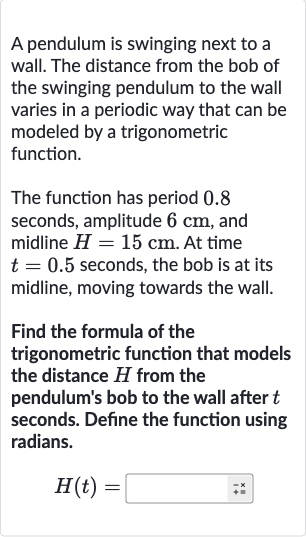AI tutor
Welcome to Bytelearn!
Let’s check out your problem:

A pendulum is swinging next to a wall. The distance from the bob of the swinging pendulum to the wall varies in a periodic way that can be modeled by a trigonometric function.The function has period seconds, amplitude , and midline . At time seconds, the bob is at its midline, moving towards the wall.Find the formula of the trigonometric function that models the distance from the pendulum's bob to the wall after seconds. Define the function using radians.
Full solution
Q. A pendulum is swinging next to a wall. The distance from the bob of the swinging pendulum to the wall varies in a periodic way that can be modeled by a trigonometric function.The function has period seconds, amplitude , and midline . At time seconds, the bob is at its midline, moving towards the wall.Find the formula of the trigonometric function that models the distance from the pendulum's bob to the wall after seconds. Define the function using radians.
- Amplitude Explanation: The amplitude of the trigonometric function is given as . This means the maximum deviation from the midline is .
- Midline Definition: The midline of the function is given as . This is the average value around which the function oscillates.
- Period Calculation: The period of the function is given as seconds. The period of a trigonometric function is related to the angular frequency by the formula . Let's calculate .
- Phase Shift Calculation: Since the pendulum is at its midline and moving towards the wall at seconds, we can use the cosine function to model the motion, as the cosine function starts at its maximum value and decreases (which corresponds to the pendulum moving towards the wall from the midline). However, we need to adjust the phase shift to account for the fact that at seconds, the pendulum is at the midline, not at an extreme. The phase shift can be found by setting the cosine function to at seconds, since the midline corresponds to the zero point of the cosine function's oscillation.Let's find using the angular frequency we calculated.Since , we need such that .
- Function Modeling: Now we have all the components to write the function. The trigonometric function that models the distance from the pendulum's bob to the wall after seconds is:Substituting the values we have:
More problems from Find a value using two-variable equations: word problems
QuestionGet tutor help
QuestionGet tutor help
QuestionGet tutor help
QuestionGet tutor help
QuestionGet tutor help
QuestionGet tutor help
QuestionGet tutor help
QuestionGet tutor help
QuestionGet tutor help
QuestionGet tutor help
